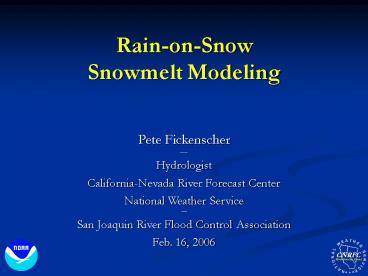RainonSnow Snowmelt Modeling - PowerPoint PPT Presentation
Title:
RainonSnow Snowmelt Modeling
Description:
National Weather Service. San Joaquin River Flood Control Association. Feb. 16, 2006 ... Snowmelt Due to Rain-on-Snow. Lf. Tw Melt (% of Px) 50 F 12.5 % 68 F 25.0 ... – PowerPoint PPT presentation
Number of Views:103
Avg rating:3.0/5.0
Title: RainonSnow Snowmelt Modeling
1
Rain-on-SnowSnowmelt Modeling
Pete Fickenscher ----- Hydrologist California-Neva
da River Forecast Center National Weather
Service ----- San Joaquin River Flood Control
Association Feb. 16, 2006
2
Snowmelt Due to Rain-on-Snow
3
Snowmelt Due to Rain-on-Snow
Simple Energy Balance
- Mr CwPx (Tw-273.16)
- Mr Melt Rate (mm)
- Cw Specific heat of water
- Px Precipitation (mm)
- Lf Latent heat of fusion
- Tw Wet-bulb Temp. (K)
Lf
Tw Melt ( of Px) 50 F 12.5 68
F 25.0
4
Rain-on-Snow
Snow-17 - Operational Equation
- M (0.0125 Px Ta)
rainmelt - 3.67 10-9 ?t/6 (Ta273)4 20.4
longwave exchange - 8.5 UADJ ?t/6(0.9 esat 6.11)
0.00057 Pa Ta - turbulent transfer
M Melt (mm) Ta Air Temperature (C) Px
water equivalent of precipitation (mm) UADJ
average wind function during rain-on-snow esat
saturation vapor pressure at the air Pa mean
sea level atmospheric pressure
5
Rain-on-Snow
Snow-17 - Operational Equation
- M (0.0125 Px Ta)
rainmelt - 6.12 10-10 ?t (Ta273)4 2734
longwave exchange - 8.5 UADJ ?t/6(0.9 esat 6.11)
0.00057 Pa Ta - turbulent transfer
- Assumptions
- no solar radiation
- relative humidity 90
- atmospheric radiation black body at Ta
- wet bulb temperature (rainwater ) Ta
- UADJ is the average wind function during
rain-on-snow events - The snowmelt occurs at the surface of the
snowpack
6
Rain-on-Snow
Snow-17 - Rainmelt
Assume a 6 hour event with constant Ta 45 F
and 2 inches of rain
7
Rain-on-Snow
Snow-17 - Longwave Radiation
Assume a 6 hour event with constant Ta 45 F
Note This melt is independent of rainfall amount
8
Rain-on-Snow
Snow-17 - Turbulent Transfer
Assume a 6 hour event with constant Ta 45 F
Note This melt is independent of rainfall
amount. UADJ set to 0.09 (12 mph wind)
9
Rain-on-Snow
Snow-17 - Component Comparison
Assume 2 inches of rain during a 6 hour event
with constant Ta
Ta Total Melt (inches) 45 F 0.50 (25)
40 F 0.30 (15) 35 F 0.11 ( 6)
Note 41 F ? 0.34 (17)
10
Example 1997 Event
11
Example 1997 Event
Dec. 30, 1996 Jan. 2, 1997
Blue Canyon (5300) Average Temp (42.5 F)
Rainfall 19.8 inches SWE loss 5.3 inches
Ratio 27
Greek Store (5600) Rainfall 13.8 inches
SWE loss 0.80 inches Ratio 6
Greek Store snowpack was deeper and less ripe,
more sheltered. Rain-on-snow melt is highly
dependent on pack conditions
12
Example 1997 Event
Dec. 30, 1996 Jan. 2, 1997
Huysink (6600) Average Temp (42.5 F) Rainfall
16.55 inches SWE loss 2.0 inches Ratio
12
Central Sierra Snow Lab CSSL (6900)
Rainfall ?? SWE loss 0.0 inches Ratio 0
At 6900 the rain passed through the deep CSSL
snowpack with no melt.
13
Example 1997 Event
Dec. 30, 1996 Jan. 2, 1997
SNOW 17 (NFDC1UP) Average Temp (41 F)
Rainfall 18.0 inches SWE loss 3.28 inches
Ratio 18
NFDC1UP is represents the basin average
rain-on-snow snowmelt
14
Snowmelt Due to Rain-on-Snow
Summary
- Rain-on-Snow is a complex phenomena.
- Many variables need to be considered.
(Temperature, humidity, wind speed, snowpack
conditions, forests,) - The strongest component is usually turbulent
transfer. - All components together may reach 25 (or more)
snowmelt-to-rain ratios in very warm events,
especially at lower elevations. - When snowpack is deep and still cold, little
additional snowmelt occurs during rain-on-snow
events.































